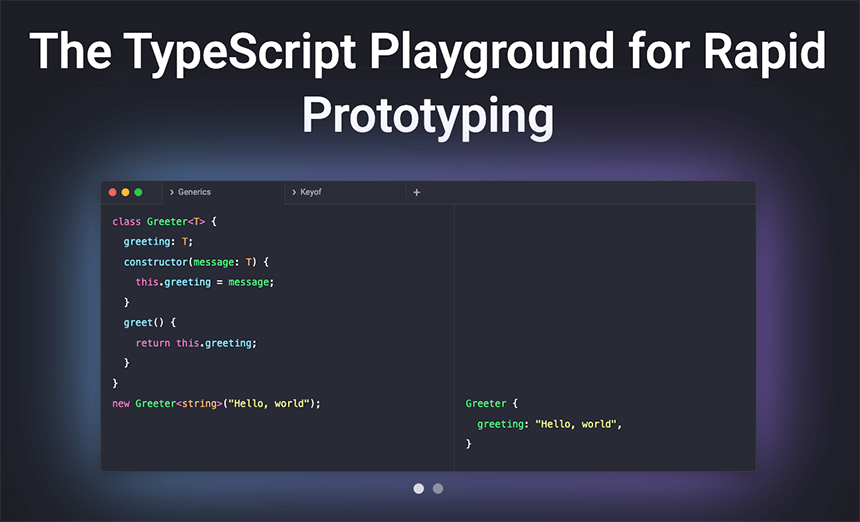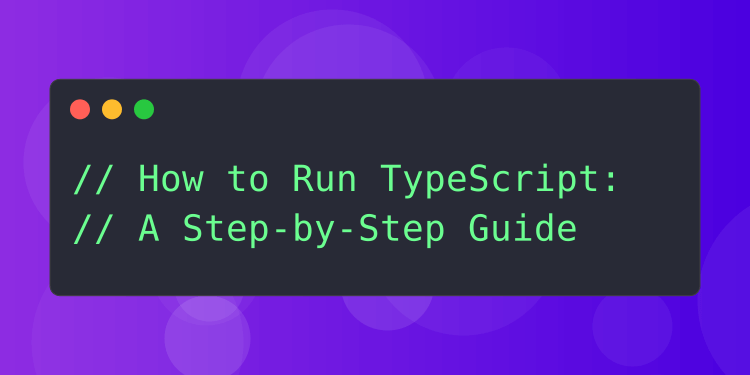TypeScript has become an important part of modern web development, offering powerful features like static typing, classes, and interfaces to enhance JavaScript applications. If you're looking to improve your coding skills and write more robust code, learning how to run TypeScript is a great place to start. This guide will walk you through various methods to run TypeScript, from setting up a local development environment to using online tools and build systems.
What is TypeScript?
TypeScript is an open-source programming language developed by Microsoft. It is a typed superset of JavaScript that compiles to plain JavaScript. TypeScript adds optional static typing, classes, and interfaces, making it ideal for large-scale applications and improving developer productivity.
Why Use TypeScript?
- Static Typing: Catch errors during development rather than at runtime.
- Enhanced Tooling: Improved code completion, refactoring, and navigation support.
- Better Maintainability: Easier to manage large codebases with clear interfaces and types.
- Modern JavaScript Features: Access to the latest ECMAScript features before they are widely supported.
Running TypeScript Locally
Running TypeScript locally involves setting up your environment to compile TypeScript code into JavaScript, which can then be executed. Here's how to do it:
Step 1: Install Node.js and npm
First, download and install Node.js if you haven't already. Node.js comes with npm, the Node Package Manager.
Verify Installation:
node -vnpm -vStep 2: Install the TypeScript Compiler
Install the TypeScript compiler globally using npm:
npm install -g typescriptStep 3: Write TypeScript Code
Create a new directory for your project and navigate into it:
mkdir typescript-democd typescript-demoCreate a file named app.ts:
// app.tsfunction greet(name: string): string { return `Hello, ${name}! Welcome to TypeScript.`;}
console.log(greet("Developer"));Step 4: Compile TypeScript to JavaScript
Compile your TypeScript code using the tsc command:
tsc app.tsThis generates an app.js file in the same directory.
Step 5: Run the JavaScript Code
Execute the compiled JavaScript file with Node.js:
node app.jsOutput:
Hello, Developer! Welcome to TypeScript.Using ts-node for Seamless Execution
ts-node allows you to run TypeScript code directly without manual compilation.
Step 1: Install ts-node
Install ts-node globally:
npm install -g ts-nodeStep 2: Run TypeScript Code Directly
Run your TypeScript file:
ts-node app.tsOutput:
Hello, Developer! Welcome to TypeScript.Setting Up TypeScript in Visual Studio Code
Visual Studio Code is a free, powerful code editor with excellent TypeScript support.
Step 1: Install Visual Studio Code
Download and install VS Code from the official website.
Step 2: Open Your Project
Open your typescript-demo folder in VS Code.
Step 3: Initialize TypeScript Configuration
In the terminal, run:
tsc --initThis creates a tsconfig.json file, which TypeScript uses to manage project settings.
Step 4: Configure tsconfig.json
Edit tsconfig.json to set your compiler options:
{ "compilerOptions": { "target": "es6", "module": "commonjs", "outDir": "./dist", "strict": true }, "include": ["./**/*.ts"], "exclude": ["node_modules"]}Step 5: Compile and Run
Compile your project:
tscRun the compiled code:
node dist/app.jsRunning TypeScript with Build Tools
For larger projects, integrating TypeScript with build tools like Webpack or Babel can streamline your workflow.
Using Webpack
Step 1: Install Dependencies
npm install --save-dev webpack webpack-cli ts-loader typescriptStep 2: Configure Webpack
Create a webpack.config.js file:
// webpack.config.jsconst path = require("path");
module.exports = { entry: "./app.ts", module: { rules: [ { test: /\.ts$/, use: "ts-loader", exclude: /node_modules/ }, ], }, resolve: { extensions: [".ts", ".js"], }, output: { filename: "bundle.js", path: path.resolve(__dirname, "dist"), },};Step 3: Update tsconfig.json
Ensure your tsconfig.json aligns with Webpack:
{ "compilerOptions": { "target": "es6", "module": "esnext", "strict": true, "esModuleInterop": true }}Step 4: Build and Run
Build your project:
npx webpackRun the bundle:
node dist/bundle.jsUsing Babel
Step 1: Install Dependencies
npm install --save-dev @babel/core @babel/cli @babel/preset-env @babel/preset-typescriptStep 2: Create Babel Configuration
Create a .babelrc file:
{ "presets": ["@babel/preset-env", "@babel/preset-typescript"]}Step 3: Compile TypeScript with Babel
npx babel app.ts --out-file dist/app.jsStep 4: Run the Compiled Code
node dist/app.jsOnline TypeScript Playgrounds
If you prefer not to set up a local environment, you can use online tools to write and run TypeScript code.
TypeScript Playground
The TypeScript Playground is an official online editor that lets you write TypeScript code and see the compiled JavaScript output instantly.
Features:
- Real-time compilation
- Option to share code via URL
- Configurable compiler options
Quick Prototyping with RunJS
RunJS is a desktop playground for JavaScript and TypeScript.

Features of RunJS
- Immediate Feedback: See the results of your code as you type.
- TypeScript Support: Write TypeScript code without any setup.
- NPM Packages: Import and use npm packages directly.
Getting Started with RunJS
- Download and Install: Get RunJS from the homepage.
- Write TypeScript Code: Open RunJS and start coding in TypeScript. The app handles compilation behind the scenes.
- No Configuration Needed: RunJS requires no setup, making it ideal for testing snippets and learning TypeScript.
Tips for Running TypeScript Effectively
- Use a Linter: Tools like ESLint can help maintain code quality.
- Type Definitions: Leverage DefinitelyTyped for third-party library type definitions.
- Incremental Compilation: Use
tsc --watchfor automatic recompilation on file changes. - Debugging: Utilize source maps for debugging TypeScript code in editors and browsers.
Conclusion
Running TypeScript is straightforward once you understand the various options available. Whether you prefer setting up a local development environment, using online tools, or leveraging applications like RunJS for quick prototyping, TypeScript offers flexibility to suit your workflow. Embrace TypeScript to write safer, more maintainable code and enhance your development experience.
